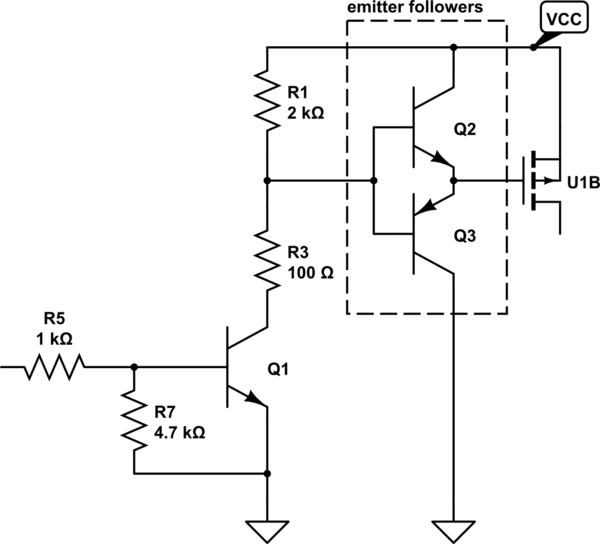If you want the high side fets to turn off faster, use something better than a 2K resistor as the pull-up. Use a 200 Ohm even. The gate capacitance multiplied by your pull up resistor gives you the ball-park time constant for the gate to charge or discharge. Multiply this by 3 to get the approximate time for full charge of the capacitor, recovering from the "ON" state, to turn off the FET.
I had a look at the FDS8958 (which was hard to read the part numbers you used in the tiny schematic picture..) datasheet and typical gate capacitance ranges from 300 to 700pF for either the N or P fet gates. Lets take worst case 700pF, the time constant is:
700pF * 2k Ohms = 1.4 microseconds.
The full discharge/charge time is about 3 times this, making the turn-off duration about 4.2 microseconds. The datasheet claims these can turn off as fast as tens of nano seconds given the following conditions for the PFET Q2:
VDD = -10 V, ID = -1 A, VGS = -10V, RGEN = 6 Ohm
So the point is, you are forcing your high side FET to turn off ~200 times slower than it's best performance. It's a high speed switching FET, yet crippled with resistance.
If you switch this at 100kHz (Not sure why you would, power switching should just be above human-hearing range of 22+kHz at most, and lower if you can to reduce switching loss) then at 50% duty cycle each high and low level only lasts for 5 microseconds. The off cycle of 4.2 microseconds means your turn-off slope consumes 85% of the off cycle, which is terrible - your FET would almost never turn off properly. This can cause cross-conduction and ruin your H bridge.
So in summary - your highside FET is not turning off very fast at all. You have great grounding strength, so it turns on nice and fast, but the 2K resistor pull up is killing it's performance and causing the anomalies you see. The fix is either put a much lower (200 ohm would be nice) pull up resistor, or even use active drive circuits like those used in integrated FET gate driver ICs. These can just be simple totem pole push-pull driver circuits, which you already have half of it set up for the grounding of the PFET gate, so just add a BJT for the high side gate drive. The easiest fix however is the gate pull up resistor. Good luck!
EDIT:
As for the current monitor for signal at node T2, have you got bidirectional current sense going on here? Remember as current flows in the opposite direction as the motor polarity is reversed, a standard single-ended ADC/current shunt monitor may not handle it properly. You can try a dual supply full rail input/output op-amp with the output given a DC bias of VCC/2, to give you bi-directional current sense.






